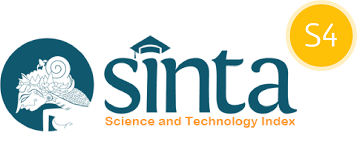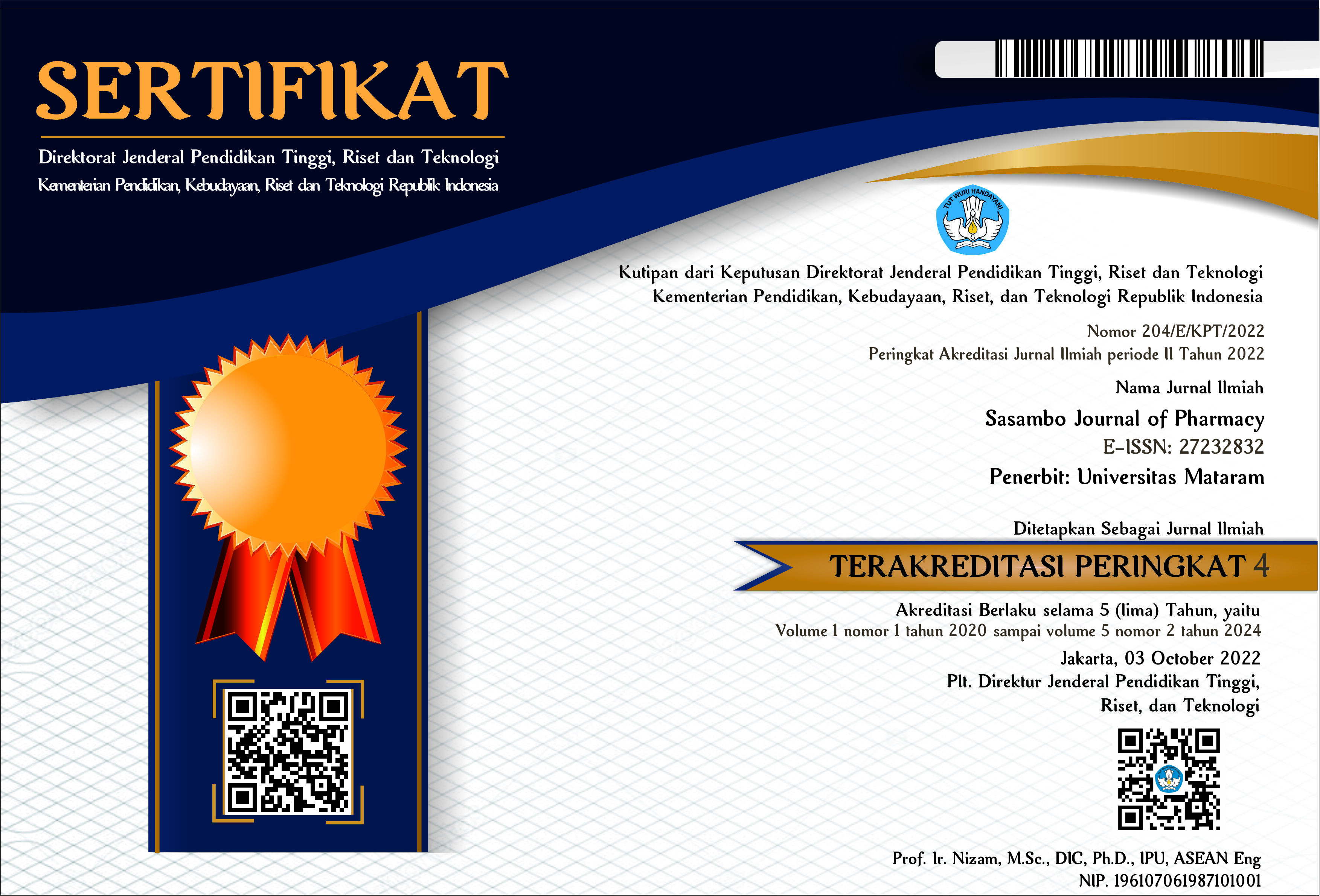Formulasi dan evaluasi sediaan sabun cair hidrosol kulit bawang sebagai antibakteri
DOI:
10.29303/sjp.v6i1.411Downloads
Abstract
Onion peels (shallots and garlic) can be developed into valuable products. One approach to utilizing onion peels is by processing them into hydrosol, which can be used in liquid soap formulations. The aim of this study is to evaluate the characteristics of liquid soap derived from the hydrosol of onion peel waste. Onion peels was processed into hydrosol by water distillation method. Hydrosol was subjected to phytochemical screening and formulated into liquid soap dosage form. Soap was made into 3 formulas with different concentrations of hydrosol in formulas F1 (5%), F2 (7.5%), and F3 (10%). The liquid soap was evaluated for characteristics including organoleptic test, pH, foam height, viscosity, and antimicrobial activity. The results of the hydrosol phytochemical screening test showed the presence of saponins and alkaloids. The results of the liquid soap organoleptic test showed that F1, F2, and F3 gave a clear color, liquid shape, and aromatic odor. F1 liquid soap pH 6.51, F2 6.44 and F3 6.43; foam height 2.50 cm, 2.10 cm, 2.33 cm; and viscosity F1 316 m.Pa.s, F2 99.99 m.Pa.s and F3 99.99 m.Pa.s. The results of the antimicrobial test of negative control (base), F1, F2, and F3 produced a clear zone. The characteristics of the soap produced provide good organoleptics, pH and foam stability. Hydrosol concentration affects the viscosity produced. Onion peel liquid soap F3 exhibit the highest average diameters of the inhibition zones 10,02±0,49 mm, and is categorized as having strong antimicrobial properties.
Keywords:
Onion peels, hydrosol, liquid soapReferences
Asni, W., Siregar, V. O., & Rusli, R. (2024). Formulation of Handwash Essential Oil and Hydrosol of Lime Peel (Citrus aurantifolia) as Antibacterials. Journal Pharmasci (Journal of Pharmacy and Science), 109-114.
Astarina, N.W.G., Astuti, K.W., Warditiani, N.K., (2013). Skrining Fitokimia Ekstrak Metanol Rimpang Bangle (Zingiber purpureum Roxb.). J. Farm. Udayana. 2(4). 1-7.
Athia, A.P., (2021). Pemanfaatan Limbah Kulit Buah Sebagai Alternatif Pupuk Organik Cair Dan Solusi Pengelolaan Sampah Di Desa Sidomulyo, Kota Bengkulu. Proc. Uin Sunan Gunung Djati Bdg. 1, 16–23.
BSN, (2017). Standar Nasional Indonesia Sabun Cair Pembersih Tangan.
BSN, (1996). Standar Nasional Indonesia Sabun Mandi Cair.
Chaaban, H., Loannou, I., Chebil, L., Slimane, M., Gerardin, C., Paris, C., Charbonnel, C., Chekir, L., Ghoul, M., (2017). Effect Of Heat Processing On Thermal Stability And Antioxidant Activity Of Six Flavonoids. J. Food Process. Preserv. 41.
Chairunnisa, S., Wartini, N.M., Suhendra, L., (2019). Pengaruh Suhu Dan Waktu Maserasi Terhadap Karakteristik Ekstrak Daun Bidara (Ziziphus mauritiana L.) Sebagai Sumber Saponin. J. Rekayasa Dan Manaj. Agroindustri. 7. 551.
Chebil, L., Humeau, C., Anthoni, J., Dehez, F., Engasser, J. M., & Ghoul, M. (2007). Solubility of flavonoids in organic solvents. Journal of chemical & engineering data, 52(5), 1552-1556.
Genatrika, E., Sundhani, E., & Oktaviana, M. I. (2020). Gel potential of red onion (Allium cepa L.) ethanol extract as antifungal cause tinea pedis. Journal of Pharmacy and Bioallied Sciences, 12(Suppl 2), S733-S736.
Hutauruk, H., Yamlean, P.V.Y., Wiyono, W., (2020). Formulasi Dan Uji Aktivitas Sabun Cair Ekstrak Etanol Herba Seledri (Apium graveolens L) Terhadap Bakteri Staphylococcus Aureus. Pharmacon. 9. 73.
Jadid, N., Jannah, A.L., Wicaksono Putra Handiar, B.P., Nurhidayati, T., Purwani, K.I., Ermavitalin, D., Muslihatin, W.,
Navastara, A.M., (2022). Aplikasi Eco Enzyme Sebagai Bahan Pembuatan Sabun Antiseptik. Sewagati. 6. 69–75.
Jang, M., Asnin, L., Nile, S. H., Keum, Y. S., Kim, H. Y., & Park, S. W. (2013). Ultrasoundâ€assisted extraction of quercetin from onion solid wastes. International journal of food science & technology, 48(2), 246-252.
Liu, Y., and Liu, C., (2015). Extraction Process Optimization Of Total Alkaloid From Actinidia Arguta: Presented At The 2015 International Conference On Materials, Environmental And Biological Engineering. 131-134.
Malik, Abd., Edward, F., Waris, R., (2016). Skrining Fitokimia Dan Penetapan Kandungan Flavonoid Total Ekstrak Metanolik Herba Boroco (Celosia argentea L.). J. Fitofarmaka Indones. 1(1), 1-5.
Muller, T., Kramer, C., Pritzel, C., Bornemann, R., Kowald, T.L., Trettin, R.H.F., Bolivar, P.H., (2018). Influence Of Cocamidopropyl Betaine On The Formation And Carbonation Of Portlandite – A Microscopy Study. Constr. Build. Mater. 163, 793–797.
Nurhayati, L.S., Yahdiyani, N., Hidayatulloh, A., (2020). Perbandingan Pengujian Aktivitas Antibakteri Starter Yogurt Dengan Metode Difusi Sumuran Dan Metode Difusi Cakram. J. Teknol. Has. Peternak. 1, 41.
Park, J., Kim, J., & Kim, M. K. (2007). Onion flesh and onion peel enhance antioxidant status in aged rats. Journal of nutritional science and vitaminology, 53(1), 21-29.
Prabowo, A., Noer, S., (2020). Uji Kualitatif Fitokimia Kulit Bawang Merah (Allium ascalonicum). Sinasis Pros. Semin. Nas. Sains 1, 250–253.
Putri, A dan Kasim, A. (2024). Hidrosol Serai Wangi: Karakteristik, Aktivitas Antioksidan dan Aktivitas Antibakteri. Teknotan. 18(2). 119-124.
Rinaldi, R., Fauziah, F., & Mastura, R. (2021). Formulasi dan Uji Daya Hambat Sabun Cair Ekstrak Etanol Serai Wangi (Cymbopogon nardus L) Terhadap Pertumbuhan Staplylococcus aureus. Jurnal Riset Kefarmasian Indonesia, 3(1), 45-57.
Rosmainar, L., (2021). Formulasi Dan Evaluasi Sediaan Sabun Cair Dari Ekstrak Daun Jeruk Purut (Citrus hystrix) Dan Kopi Robusta (Coffea canephora) Serta Uji Cemaran Mikroba. J. Kim. Ris. 6, 58.
Rowe, R.C., Sheskey, P.J., Quinn, M.E., (2009). Handbook Of Pharmaceutical Excipients, 6th Ed. Rps, USA.
Sa’adah, H., Supomo, S., Musaenah, M., (2020). Aktivitas Antibakteri Ekstrak Air Kulit Bawang Merah (Allium cepa L.) Terhadap Bakteri Propionibacterium Acnes. J. Ris. Kefarmasian Indones. 2, 80–88.
Said, A., Harti, R., Dharmawan, A., Rahmah, T., (2015). Pemisahan Hidrosol Hasil Penyulingan Minyak Atsiri Dengan Metode Elektrolisis Untuk Meningkatkan Rendemen Minyak. Khazanah 7, 82–94.
Shafie, M. H., Kamal, M. L., Razak, N. A. A., Hasan, S., Uyup, N. H., Rashid, N. F. A., & Zafarina, Z. (2022). Antioxidant and antimicrobial activity of plant hydrosol and its potential application in cosmeceutical products. Jundishapur Journal of Natural Pharmaceutical Products, 17(4).
Suryani, A., Sailah, I., Hambali, E., 2000. Teknologi Emulsi. Institut Pertanian Bogor, Bogor.
Tsao, R. (2010). Chemistry and biochemistry of dietary polyphenols. Nutrients, 2(12), 1231-1246.
Wijayanti, R., dan Rosyid, A. (2015). Efek Ekstrak Kulit Umbi Bawang Putih (Allium sativum L.) Terhadap Penurunan Kadar Glukosa Darah pada Tikus Putih Jantan Galur Wistar yang Diinduksi Aloksan. jurnal ilmu farmasi dan farmasi klinik, 12(1), 47-52
Zhao, J., Yang, J., Xie, Y., (2019). Improvement Strategies For The Oral Bioavailability Of Poorly Water-Soluble Flavonoids: An Overview. Int. J. Pharm. 570.
Zulkifli, M., Estiasih, T., (2014). Sabun Dari Distilat Asam Lemak Minyak Sawit. J. Pangan Dan Agroindustri 2, 170–177
License
Copyright (c) 2025 The Author(s)

This work is licensed under a Creative Commons Attribution 4.0 International License.
Authors who publish with Sasambo Journal of Pharmacy (SJP), agree to the following terms:
- Authors retain copyright and grant the journal right of first publication with the work simultaneously licensed under a Lisensi Creative Commons Atribusi 4.0 Internasional. This license allows authors to use all articles, data sets, graphics and appendices in data mining applications, search engines, web sites, blogs, and other platforms by providing an appropriate reference. The journal allows the author(s) to hold the copyright without restrictions and will retain publishing rights without restrictions.
- Authors are able to enter into separate, additional contractual arrangements for the non-exclusive distribution of the journal's published version of the work (e.g., post it to an institutional repository or publish it in a book), with an acknowledgment of its initial publication in Sasambo Journal of Pharmacy
- Authors are permitted and encouraged to post their work online (e.g., in institutional repositories or on their website) prior to and during the submission process, as it can lead to productive exchanges, as well as earlier and greater citation of published work (See The Effect of Open Access).







